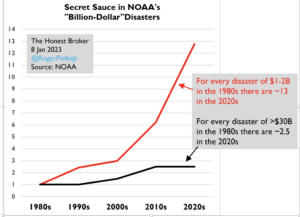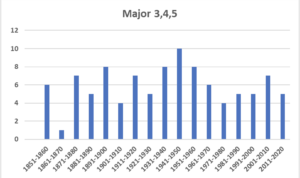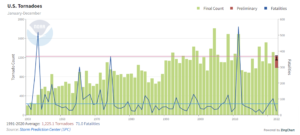Each year, the National Oceanic and Atmospheric Administration (NOAA) issues its “Billion Dollar Event” report, detailing the number of weather events across the United States causing $1 billion or more in property damage. And every year, it touts this report as proving the damaging effects of man-made climate change. And every year, despite glaring flaws, the press picks it up and dutifully repeats both the numbers and the message.
In recent coverage of the report, Colorado Sun environmental reporter Michael Booth writes that:
“NOAA researchers tallied 18 separate billion-dollar-plus weather and climate disasters in 2022, the third largest count in 43 years of inflation-adjusted record keeping, and the third-costliest year.”
This is government-made junk science, and the Sun is amplifying and enabling it.
As Roger Pielke, Jr. of the University of Colorado’s Department of Environmental Studies has been pointing out for over a decade, the NOAA report simply fails to account for economic development over time. Naturally, the number of $1 billion events will increase over time, even if the weather stays the same, and even if NOAA correctly accounts for inflation.
Pielke believes that man-made climate change is not only real, but presents a serious long-term problem that needs to be solved through a combination of changing power sources and mitigation of effects. He parts company from the climate alarmists, though, when he discredits the more catastrophic models and challenges reports such as NOAA’s.

This year, Pielke takes a deeper dive into NOAA’s numbers and shows precisely how the report does little but mislead. He points out that hurricane losses, for example, are exaggerated by the significant population and property value increases in the state of Florida over the last 40 years. The state’s economic growth far exceeds a simple inflation adjustment. But the $1 billion metric is blind to that development.
Moreover, NOAA has created a conflict of interest for itself by judging property damage values itself. NOAA is a climate and weather agency, not an insurance or economics agency. This would be a problem under the best of circumstances. But they’re not the best of circumstances. NOAA has been, in Pielke’s words, “somewhat aggressive when it comes to getting events over that $1 billion threshold.” The number of events just over that mark has increased far faster than the number of more expensive events (see Figure 1), and the percentage losses to the economy have decreased over time (see Figure 2), something that makes no sense given NOAA’s assertion that weather losses are getting worse.
The Sun article also states:
“Elsewhere in the U.S., rising ocean temperatures and other climate changes are raising the number of category 4 and 5 hurricanes that hit the Gulf Coast and southeastern seaboard, the kinds of weather catastrophes that create the costliest property damage. Those damage totals balloon as popular coastal areas develop and face an increase in major storms.”

But NOAA’s own hurricane data belies this claim (see Figure 3). The number of major hurricanes, defined as Category 3, 4, or 5, making landfall in the US, shows no perceptible upward trend, and in fact peaked in the 1930s, 40s, and 50s.
We should also note that the Sun acknowledges the effect of population increase and property development in the Sunshine State, but uses that fact to bolster NOAA’s sensationalism rather than to show how it undermines it.

The same is true for annual tornado count (see figure 4).
We see an increase in tornado count from about 1950 to 1973, then a decline until 1990, and then a sudden jump after which we see no increasing trend. Interestingly, we see greater resiliency, with the same number of tornadoes taking the same number of lives, even as the US population increases (with the exception of a number of catastrophic tornadoes in 2011).

Finally, NOAA’s own assessment of hail readings, issued in 2009, argues that measurement rather than climate, is likely to blame for the increasing number of reported large hail events: “… in general, the inflation in the number of reports is likely more a reflection of changes in society and the NWS reporting system than in the severe hail event climatology.” It then goes on to detail both those changes, and changes in technology and operational methodology.
In short, NOAA is producing bad science which finds its way both into the public discourse and into policymaking. It should be the job of the press to question these numbers, not to repeat them uncritically, especially when they contain such glaring errors.
Joshua Sharf is senior fellow in fiscal policy at the Independence Institute, and a regular contributor to Complete Colorado.


